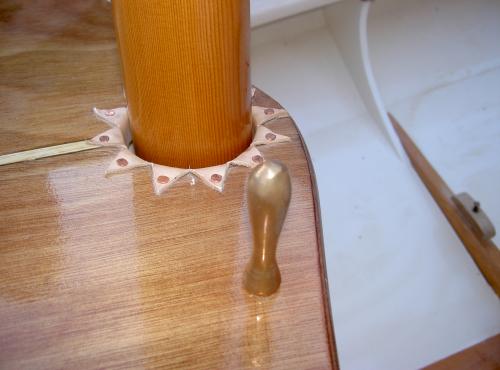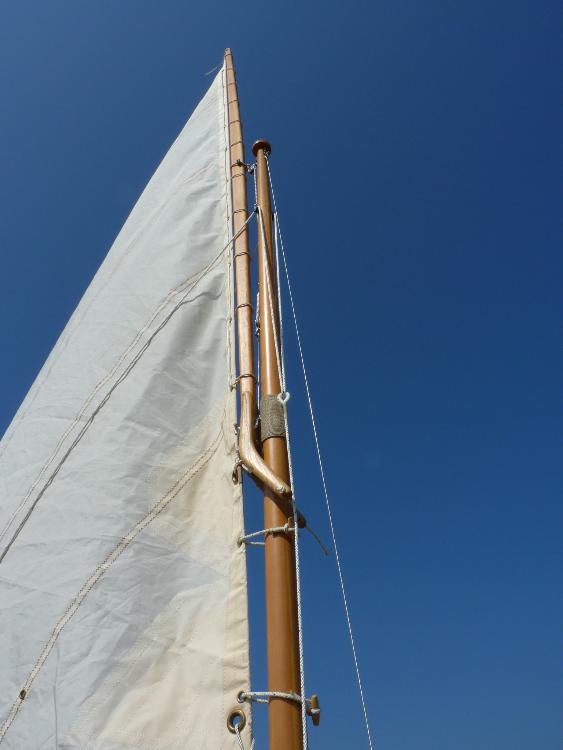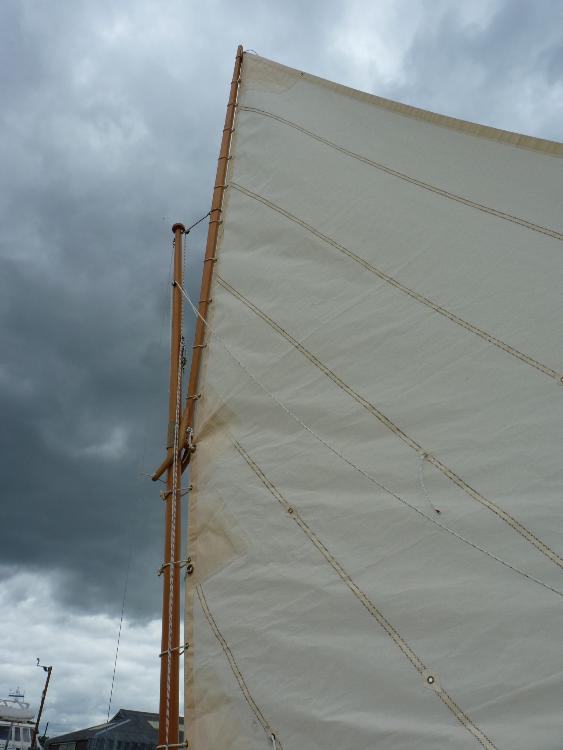Mast Help
|
|
Hi All,
As ever my posts on here are a request for help. On my last boat the wood was all varnished with Internationals Original varnish. This was ok, but the mast used to wear through every year and need stripping back and starting again. I have heard people using different varnish for the mast and even epoxy coating. Having bought an expensive bit of Sitka Spruce and spent three weekends shaping and sanding it I want to give it the best chance possible. If it makes a difference it is for a Wolstenholme Coot Thanks for any help you can offer James |
|
|
Leather?
I can't speak from experience on that, but it does seem to be used a lot. Epoxy will get marked by the friction of the jaws or whatever rubs on the mast, but not be penetrated through to the wood. However, it is more difficult to get a good looking finish to begin with. I use varnish (currently Blackfriars marine from the local hardware store) and renew as and when, if the mood takes me. |
|
|
Does depend on where it is wearing through. I put leather round the mast where it fits through the thwart. Have seen people similarly protect the mast where the boom fits, though I have a gooseneck so not needed. Other area of potential wear is around the gaff/mast interface. Suspect leather on the gaff would be a bit clunky, even worse on the mast.
My preferred solution is to oil rather than varnish. Have (infamously) used B&Q Decking oil with very sound results but also tried Deks Olje, Varnol and Sikkens products. because they don't create that glossy surface finish they don't seem to wear noticeably and are very easy to top up if the wood is looking starved at any point. Tim |
|
|
I used thin copper sheet, tacked to the mast where the gaff and boom jaws used to bear to good effect. I also lined the jaws with hard leather (some offcuts obtained free gratis from a saddlemaker). This worked very well indeed at keeping wear and tear on the mast at bay, although I found that the parrel beads then tended to wear quite badly instead.
|
|
|
In reply to this post by james gilchrist
Hi James,
Before you apply any varnish, if you haven't done it already I'd recommend doing something to stop the mast rotating, I thought the fore-stay would be enough to stop this but it doesn't. It does it mostly when the boat is on the launch trailer with its nose down, where the weight of the boom pushes the gooseneck round. I had to make an after-market adjustment to mine by cutting a semicircle off the base an gluing it onto the mast step. No-doubt you've got this covered. I would think about putting one of those star shaped bits of leather round the hole in the partner thwart, I did this on my Whilly Tern.  or else just a band of leather round the actual mast. I don't find the gaff jaws are a problem but the shackle on the short strop from the throat halyard has caused some damage, I've whipped that with what is supposed to be a temporary lashing but It's probably stuck there now. I would recommend using an oil based product rather than varnish. You can overcoat with just a light rub with a cloth soaked in the oil. Very Theraputic and gives you an excuse to stroke her. The stuff you can see on the Whilly is Le Tonkinoise and I can recommend it, lovely stuff to work with and no sanding between coats. I used the infamous B&Q decking oil on the Coot and its lasted well on the spars but I've gone over to Varnol for the rest of the hull. Apparently its now on short supply so its probably over to Deks Olje or something similar. Graham. |
|
|
Hi Graham, Many thanks. I will go with oil not varnish. Did you use commercial gaff and gooseneck or make your own. I have been working on anti rotation device myself, but thanks for the tip James
|
|
|
Hi James,
The goose neck is from a Mirror, which I bought from Trident They also made up the forestay for me. The gaff jaws are home made, they are a tad too long but work fine, I put some leather in the heel between the jaws. Cheers Graham |
|
|
Thanks any pics would be great James Sent from my iPad
|
|
|
OK James, Here we go with the true confessions of a rank amateur for the enlightenment and entertainment of all.
 Andrew Wolstenholme doesn't give any dimensions on the plans for the gaff jaws so it was a case of making it up as I went along. The mast is much wider than the yard so I decided to make the jaws splayed on wedge shaped blocks but they could equally have been made parallel. Obviously the jaws need to straddle the mast in both the horizontal and vertical positions so I had to play around with the bevel gauge to decide what angle the jaws should be at. So what's wrong with this picture? Well the rig is a high peaked gaff, not a gunter, so the yard shouldn't be chock-a-block like this. I discovered this after I'd submitted the photos for my Watercraft article and Andrew, who had the editorial veto, well veto'd it, so it was back to the photo shoot location on a cloudier day. You'll also notice the previously mentioned whipping on the mast to protect it from the end of the short strop between the jaws and the throat halyard. I've attached the strop to the yard by a rope loop which though effective is a bit clumsy. When I spoke to Andrew at Beale Park he suggested cutting a slot in the throat and pinning the strop though horizontally which would be a more elegant solution.  This photo shows the correct angle for the yard and clearly shows that the jaws are longer than they really need to be. I stole the idea of having ribands with toggles round the mast from Chris Waite. They are quick to rig and save the problem of the lacing going all saggy when you drop the sail or put in a reef. Unfortunately I made mine a bit tight so the yard doesn't want to drop by itself. In fact I could probably manage fine with half the number which solves the problem. Have fun and post more photos. Regards Graham |
«
Return to Builds in Progress
|
1 view|%1 views
| Free forum by Nabble | Edit this page |


